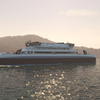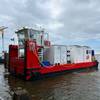With the first quarter of this year behind them, Sailors pursuing engineering-based ratings are now up to speed with computer-based training (CBT) that offers 150 lessons previously requiring classrooms and instructors.
The first phase of CBT was launched at the Basic Engineering Common Core (BECC) over a year ago as training was reconfigured to eliminate the legacy “A” School system and replace it with a standardized engineering program for all ratings as part of the Revolution in Training.
Sailors pursing engineering ratings spend the first three weeks at Damage Control, training in firefighting, flooding emergencies and chemical, biological and radiological (CBR) warfare. The remainder of the curriculum is spent mastering engineering fundamentals. This includes portions of the Master Light-off checklist, in which a student must find up to 52 different space discrepancies to successfully pass BECC.
The final phase of CBT was implemented in January.
“We have also put in a split shift so a student will come in on days, shift to nights and come back on days,” said EMCS (SW) Jeff Childress, director and course manager for BECC. “Most of the lessons for damage control were shifted to evenings, then back to engineering during days.”
By acquiring work stations from other learning centers that were shut down, BECC added computers and now have a total of 525 stations available for students, and an additional 50 stations dedicated solely for testing.
“With the split schedule and additional workstations, we went from accommodating 800 students to in excess of 1,200 to 1,400 during peak surge in January and February. Seventy percent were in front of a computer while 30 percent were in labs,” Childress said.
With 150 lessons available online that were previously covered in a classroom-instructor setting, more students can access the Navy standardized material, with a schedule that allows for more students per day in training.
While classes are started on a schedule, students are self-paced in the CBT portion, allowing some to finish in as little as five weeks, according to Childress.
“We see some complete the course sooner than normal and now that the entire course is available on Navy Knowledge Online (NKO), even delayed entry Sailors can complete some of the course work before they start boot camp; it will significantly reduce the amount of their training time.”
While a large percentage of the knowledge based course is done via CBT, students have access to facilitators, utilizing a bull pen, drawing on various ratings within the school.
“If we have a facilitator in a different rating actively engaged in other classrooms, they can key in on radio and ask for other ratings to come in and help a student,” Childress explained. “We rotate facilitators so they can answer to that specific area.”
Childress says students’ reactions are mixed regarding self-paced training verses the classroom and instructor combination. “Some just came from high school and are used to having a teacher in front of them, so CBT is a different concept for them, but others are very comfortable with it.”
Following the course, all electrical rating students complete the Module 9-Charlie, which Childress calls a hard-core two weeks of hands-on electrical trouble shooting and maintenance. “They do trouble shooting, small boat ops, and lighting. It is very hands on,” he said.
The Navy also plans to further develop coursework for the journeyman and master level ratings.
“The funding of the engineering plant course, the “C” school side, is in progress,” said Childress. “A lot of their material is still done in the classroom setting.”
By Susan Koerner, Training Support Center Great Lakes Public Affairs
Subscribe for
Maritime Reporter E-News
Maritime Reporter E-News is the maritime industry's largest circulation and most authoritative ENews Service, delivered to your Email five times per week










